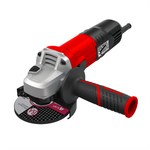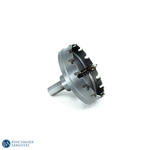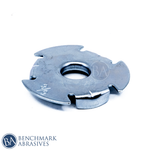
Bonded Abrasives Vs Coated Abrasives

There are two major types of abrasive tools used for surface finishing and material removal. They vary greatly in terms of uses, performance, qualities and their constructions. In this article, we will cover all the details regarding bonded and coated abrasives, their differences and how to choose between them.
WHAT IS BONDED ABRASIVES?
Abrasive grains bound together by a bonding agent make up bonded abrasives. This mixture is molded into shapes like wheels, stones, segments, or mounted points, then solidified. Common types include vitrified clay, resin, rubber, and metal. Key features of bonded abrasives are:
- Abrasive grains: these are the cutting particles that can be natural or organic, including emery or corundum, or they can be synthetic or created like aluminum oxide, silicon carbide, diamond, etc.
- Bonding Agent: The bonding agent is crucial for an abrasive tool's strength and durability, as it's the material that holds the abrasive grains together. Common types include vitrified, resinoid, rubber, metal, and silicate bonds.
APPLICATIONS OF BONDED ABRASIVES
Bonded abrasives are a highly versatile tool and can be used for a wide range of applications, including removal of heavy stock, fine finishing, blending, polishing, and deburring of in various sectors, including metal fabrication, tool and die making, automotive and aerospace. The particular bonded abrasive type (material, grit size, bond type, and form) is chosen with care, taking into account the equipment being used, the material being treated, and the intended result.
WHAT IS COATED ABRASIVES?
Coated abrasives are made up of abrasive grains glued to a flexible backing material which can be paper, cloth, fiber, film, plastic, or a mix of these. Adhesives or bonds, sometimes in several layers, are used to stick the grains to the backing. The abrasive grains are available in various sizes (grits) and materials. The following are the key features of coated abrasives:
- Backing Material: This gives the abrasive its flexibility and structural stability. Common types of backing materials are paper, cloth, film, fiber plastic, and much more.
- Adhesive (Bond): The adhesive (bond) in sandpaper has two main layers: the maker coat, which initially binds the abrasive grains to the backing, and the sizer coat, which adds rigidity and durability. Some specialized sandpaper also includes a top coat for properties like heat resistance or anti-clogging.
APPLICATIONS OF COATED ABRASIVES
Coated abrasives are quite versatile, excelling at every task from heavy stock removal to fine finishing, deburring, polishing, and blending. Their flexibility allows them to be molded into various shapes and curves. You will find them widely used in surface preparation, metalworking, woodworking, and automotive body repair.
COMPARISON BETWEEN BONDED AND COATED ABRASIVES
Here is a detailed comparison between bonded and coated abrasives on the basis of different factors.
- Material Removal Rate: When compared to coated abrasives, bonded abrasives usually offer a better or higher material removal rate due to their stiff three-dimensional structure, which safely holds abrasive grains within the bond. This enables high grinding forces, deeper cuts, and effective chip formation and clearance. Coated abrasives, on the other hand, have a lower to moderate material removal rate due to their flexible structure and a layer of abrasive grains bonded to the backing material, which enables lower grinding forces, making them possible for cloggings and shallow cuts.
- Surface Finish: By using bonded abrasives, you can get a variety of finishes starting from rough grinding to fine polishing based on the grit size and bond type. Although they are highly recommended for stock removal over very fine finishing. Coated abrasives are perfectly ideal for generating smooth and even surface finishes due to the evenly distributed grains on a flexible backing. They come in an extensive range of grit sizes, which makes them perfect for fine sanding, polishing, and getting particular surface textures.
- Flexibility and Conformability: The fixed form of bonded abrasives limits their use. They are ideally suitable for flat or even surfaces. The flexible backings of coated abrasives make them ideal for situations where the abrasive must adhere to uneven or curved surfaces. They are mostly preferred for finishing and sanding contoured surfaces.
- Versatility: bonded abrasives are more specialized for particular grinding, sharpening, and cutting projects, which usually require special machinery. Coated abrasives on the other hand, are extremely adaptable because of their many different shapes and flexibility to be used with both hand and power tools for a wide range of tasks, from delicate finishing to heavy stock removal.
- Durability and Lifespan: In general stronger and long-lasting, particularly in applications involving intense cutting and grinding, since the connection keeps the abrasive grains in place. Periodically "dressing" them to reveal new abrasives may be necessary. Bonded abrasives, when compared to coated abrasives, can quickly wear down, mainly under excessive pressure or while aggressive material removal, due to the single layer of grains being directly worn. However, their lifespan can be extended with the help of special coatings.
- Heat Generation and Management: bonded abrasives require coolant during the process as they are capable of generating a certain amount of heat when grinding aggressively. Coated abrasives also generate heat that can cause loading or clogging of the abrasive surface with removed material, mainly when using finer grits or higher pressure.
- Cost: Bonded abrasives are more expensive when it comes to specialized, high-performance grinding wheels. Coated abrasives, on the other hand, are more economical and cost-effective for dealing with different ranges of applications, especially for light to moderate material removal and finishing.
- Applications: Bonded abrasives are mostly used for accurate grinding of metal parts, cutting ceramics, metals, and other hard materials, sharpening tools and edges, heavy stock removal, creep feed grinding, and form grinding. Coated abrasives are majorly used for sanding and finishing different materials, including wood, plastic, composites, metal, and painted surfaces, deburring, surface preparation for coatings, paintings or weldings, polishing, contour sanding and finishing of intricate shapes, rust, and paint removal.
CHOOSING THE RIGHT ABRASIVE
Selecting between the bonded abrasive and coated abrasive is totally based on their application requirements, which involve the following factors:
- The type of material you are working with
- The quantity of a material to be removed
- The required surface finish
- The workpiece’s shape
- The required tools
- The price factor
By being aware of these variations, you may choose the best abrasive for your requirements, resulting in effective material removal, the required surface quality, and increased productivity.



































































